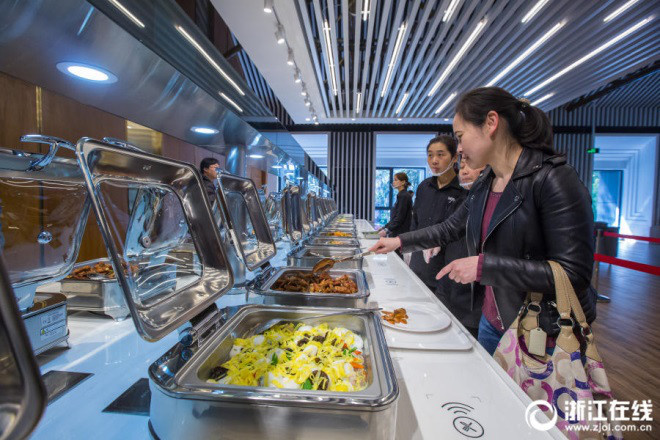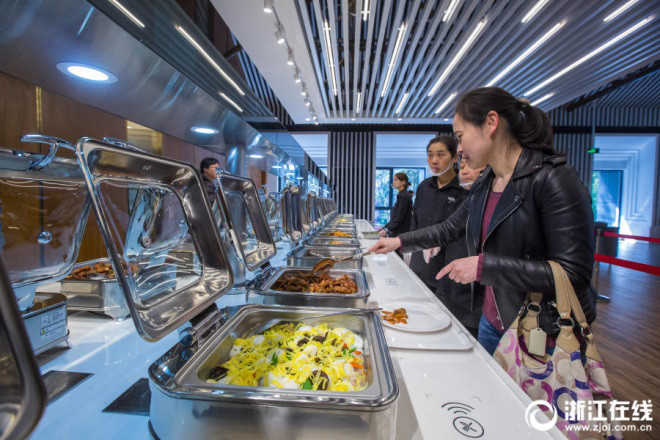By Bai Yang from People’s Daily

Faculty of Zhejiang University are selecting food in the cafeteria. Sensors installed can calculate weight and calories of the food. (Photo from zjol.com.cn)
China is going full steam ahead toward a cashless society, which can be evidenced by the emergence of diversified forms of mobile payments. The facial recognition payment technology, for instance, allows consumers to process their payment without taking out their wallets, or even their smartphones.
An old canteen at Yuquan campus of Zhejiang University recently became an Internet sensation rightly because of the facial recognition payment and intelligent identification it introduced.
The diners in the canteen need to have their faces scanned before taking a chip-embedded food tray. After they select their meals, the smart recognition system will count the food’s total weight and calories and go through payment process for them.
A report specifying the bill and nutrition content will also be sent to diners’ phones through mobile application.
The progress in China came as the facial recognition payment still stands at an early stage around the world because of its tough requirements on software, hardware, technology maturity, as well as safety.
Alipay, an affiliate of Chinese e-commerce giant Alibaba, introduced facial recognition payment solution at a KFC outlet in Hangzhou, Zhejiang province last September. It was the debut of the technology’s commercial use in the world.
Facial recognition payment and other emerging ways are not only a showcase of China’s strength in technology, but also a reflection of its accelerated pace toward cashless society.
Statistics released by China’s Ministry of Industry and Information Technology indicated the rapid development of the country’s mobile payment in recent years. In the first ten months of 2017, the country's mobile payment transactions totaled 150 trillion yuan ($24 trillion), ranking No.1 in the world.
A report from consulting firm iResearch also showed that in 2016, as much as 54.8 percent of third-party payment transactions in China occurred via mobile payment method.
Chinese online payment service providers also expanded their sphere to overseas destinations. Last year, tens of thousands of foreign merchants across 36 countries and regions accepted Alipay as a payment option, with the total transaction numbers tripling year on year.
By last July, Chinese tech giant Tencent’s WeChat Pay had also been used in 20 countries and regions, processing transactions in 13 currencies.
An old canteen at Yuquan campus of Zhejiang University recently became an Internet sensation rightly because of the facial recognition payment and intelligent identification it introduced.
The diners in the canteen need to have their faces scanned before taking a chip-embedded food tray. After they select their meals, the smart recognition system will count the food’s total weight and calories and go through payment process for them.
A report specifying the bill and nutrition content will also be sent to diners’ phones through mobile application.
The progress in China came as the facial recognition payment still stands at an early stage around the world because of its tough requirements on software, hardware, technology maturity, as well as safety.
Alipay, an affiliate of Chinese e-commerce giant Alibaba, introduced facial recognition payment solution at a KFC outlet in Hangzhou, Zhejiang province last September. It was the debut of the technology’s commercial use in the world.
Facial recognition payment and other emerging ways are not only a showcase of China’s strength in technology, but also a reflection of its accelerated pace toward cashless society.
Statistics released by China’s Ministry of Industry and Information Technology indicated the rapid development of the country’s mobile payment in recent years. In the first ten months of 2017, the country's mobile payment transactions totaled 150 trillion yuan ($24 trillion), ranking No.1 in the world.
A report from consulting firm iResearch also showed that in 2016, as much as 54.8 percent of third-party payment transactions in China occurred via mobile payment method.
Chinese online payment service providers also expanded their sphere to overseas destinations. Last year, tens of thousands of foreign merchants across 36 countries and regions accepted Alipay as a payment option, with the total transaction numbers tripling year on year.
By last July, Chinese tech giant Tencent’s WeChat Pay had also been used in 20 countries and regions, processing transactions in 13 currencies.
 Menu
Menu
 China goes full steam ahead toward cashless society
China goes full steam ahead toward cashless society
















